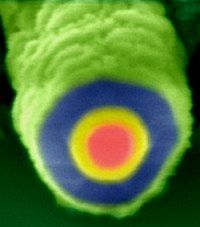
Power hungry technology is changing every passing second. From devices in day to day use to bioterorrism monitors, they all need power to run. To find efficient, renewable and environment friendly sources for power in already starving situation is a challenge.
In what is being considered a breakthrough in nano technology, a silicon wire, hundred times smaller than human hair and virtually invisible to the naked eye have been developed by the Harvard chemists.
Three different kinds of silicon wires, each different in electrical properties were wrapped in a layer to create a wire. The electrical charges take place when a process between the outer shell and cores take place due to exposure to the light.
Although the energy generated is about 200 Pico watts per strand, the technology might have its limitations, but at nanoscale it is sufficient to run ultra low power devices.
The photosensitive nanowire apart from converting light into electricity carries it to ultra small circuits, such as nano sensors, flexible devices and possible sewn into clothes or worn as patches.
Although nanoscale Photovoltaic cells (PV cells) are not new, Charles Lieber’s material is unique.
With an efficiency of converting from 3.4% to 5% of sunlight into electricity, the nanowires can withstand light without deteriorating and are much cheaper than other nanoscale photovoltaic devices.
The commercial viability is one aspect that needs more research. Traditional solar cells are about 20% efficient, if at a nano scale 10-15% of efficiency can be achieved, it will be remarkable.
Charles Leiber is pretty optimistic about commercial viability. As he says,
It will have to be unique to be an economically viable application, some place where you want durability and flexibility, where if it gets destroyed, people don’t care
Image Credit
Via: Zdnet




